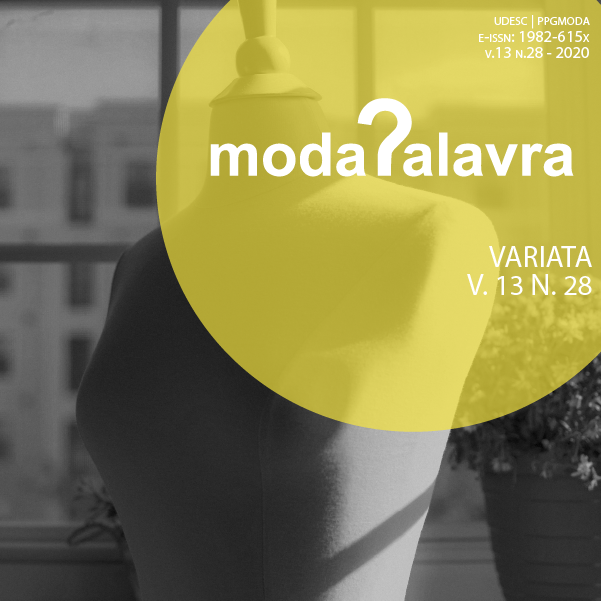Design and emotion: methods and technique for emotional evaluation of fashion goods
DOI:
https://doi.org/10.5965/1982615x13272020130Keywords:
emotional design, fashion, project methodologyAbstract
The presentation of methods and techniques for the emotional study of products is proposed, with a clipping of research for fashion goods. The kansei engineering method wil l be explored in a descriptive and applied way, to help understand the emotions that users confer on products. Using focus group techniques, the objectives are to discuss the fashion and consequent selection of data to use with the method. In addition, the construction and application of the semantic differential scale will be used to record users’ emotional impressions. The results, obtained with the applied method associated with the techniques; aim to present the relationship between the interviewees’ em otional perception and design elements of the fashion goods that compose a clothing structure. Hence, the emotional significance attributed by users to products can be understood and converted into design requirements to develop new products. The presented method associated to the techniques is considered efficient and may be integrated to the practice of designDownloads
References
BARTHES, Roland. Sistema da moda. trad. do francês por Lineide do Lago Salvador Mosca. SP: Cia. Ed. Nac./Ed. da Universidade de São Paulo, 1979, 328p.
BALDUINO, Mariana Araújo. Aplicação da metodologia de engenharia Kansei na análise de consumo de chás. 2012. 90 f. Dissertação (Mestrado) - Ciências do Consumo e Nutrição, Geociências, Ambiente e Ordenamento do Território, Universidade do Porto, Porto, 2012.
CIDREIRA, Renata Pitombo. Os Sentidos da Moda. São Paulo: Annablume, 2006. 146 p.
DAMÁSIO, António R.. O erro de Descartes: Emoção, razão e o cérebro humano. São Paulo: Companhia das Letras, 1996. Tradução de: Dora Vicente e Georgina Segurado.
DESMET, P. M. A.; HEKKERT, P.. The basis of product emotions. In: W.green And P. Jordan (eds.), Pleasure With Products, Beyond Usability, London, p.60-68, 2002.
FONTOURA, Antônio M. e ZACAR, Cláudia R. Hasegawa. Quando o design mexe com a gente. In: abc Design. Ed n. 25. Curitiba, 2008. ISSN 1676-5656.
GONDIM, Sônia Maria Guedes. Grupos focais como técnica de investigação qualitativa: desafios metodológicos. In: PAIDÉIA, 12., 2003, Salvador: UFBa, p. 149 - 161.
GONDIM, Sônia Maria Guedes. Grupos focais como técnica de investigação qualitativa: desafios metodológicos. In: PAIDÉIA, 12., 2003, Salvador. Paidéia. Salvador: Universidade Federal da Bahia, 2003. p. 149 - 161.
GOLEMAN, Daniel. Inteligência emocional: a teoria revolucionária que redefine o que é ser inteligente. Rio de Janeiro: Objetivo, 1996. 383 p. Tradução de: Marcos Santarrita.
JUNIOR, L. D. F.; BENASSI, J. L. G.; AMARAL, D. C.. Kansei Engineering na gestão ágil de projetos de novos produtos: potencialidades e desafios. In: GESTÃO DA PRODUÇÃO, OPERAÇÕES E SISTEMAS. Ano 6, 2011. p. 59 - 76.
JORDAN, Patrick W.. Human factors for pleasure in product use. Applied Ergonomics, [s. L.], v. 29, n. 1, p.22-33, nov. 1996.
LOKMAN, Anitawati Mohd. DESIGN & EMOTION: THE KANSEI ENGINEERING METHODOLOGY. In: Revista Faculty of Computer and Mathematical Sciences, 2010, Malaysia: Universiti Teknolgi Mara, 2010. p. 1 - 14. ISSN 2231-7473.
MARGHANI, V el. et al. Kansei Engineering: metodologia orientada ao consumidor para suporte a decisão de projeto. 8º Congresso Brasileiro De Gestão De Desenvolvimento De Produto. 12, 13, 14 de setembro de 2011. Porto Alegre-RS, 2011. p 1-13.
MYERS, David G.. Psicologia. Rio de Janeiro: Ftc, 2006. Tradução de Eduardo Jorge Custódio da Silva; Maria dos Anjos Santos Rouch.
NAGAMACHI, Mitsuo. Kansei Engineering as an ergonomic consumer-oriented technology for product development. Applied Ergonomics, Hiroshima, p.289-294, 2002. Dept. of Kansei Ergonomics. Hiroshima International University.
NIEMEYER, Lucy. Design atitudinal: Uma abordagem projetual. In: MONT'ALVÃO, Claudia; DAMÁZIO, Vera (Org.). Design ergonomia emoção. Rio de Janeiro: Faperg Mauad, 2008. Cap. 3. p. 49-64.
NORMAN, Donaldo A.; DEIRÓ, Tradução Ana. Design emocional: Por que adoramos (ou detestamos) os objetos do dia-a-dia. Rio de Janeiro: Racco, 2008. 278 p.
Downloads
Published
How to Cite
Issue
Section
License
Copyright (c) 2020 Carina Santos Silveira, Suzi Maria Carvalho Mariño

This work is licensed under a Creative Commons Attribution-NonCommercial 4.0 International License.
When submitting an article for publication in ModaPalavra e-periodico, the author (s) agree (s) with the following terms:
- Authors maintain the copyright in their manuscripts and grant the journal the right of first publication, with work simultaneously licensed under the Creative Commons Attribution-NonCommercial 4.0 International, which allows sharing the work with the acknowledgment of authorship and the initial publication in the journal without payment ;
- Authors may use the same results in other publications after the first publication, provided that they indicate ModaPalavra e-journal as the original publication medium;
- Authors are authorized to take additional contracts, separately, only after the original publication in ModaPalavra e-journal, provided they indicate ModaPalavra e-journal as the original publication medium;
- Authors are allowed and encouraged to publish and distribute their work online (eg in institutional repositories or on their personal page), only after the editorial process and the first publication, provided they indicate ModaPalavra e-journal as the original publication medium;
- To indicate ModaPalavra e-journal as the original publication medium, authors should use the following text template: "This article was originally published by ModaPalavra e-periodical, under a CC BY NC license, in its volume [insert volume] number [insert number] in the year of [insert year], and can be accessed at: http://www.revistas.udesc.br/index.php/modapalavra/ ";
- The opinions expressed in the articles are the author’s sole responsibility, not necessarily reflecting the journal’s opinion. The publication of any material that is owned and held in copyright by a third party, including – but not limited to - articles, photos or drawings was previously authorized by their representatives to be published in ModaPalavra e-journal.









